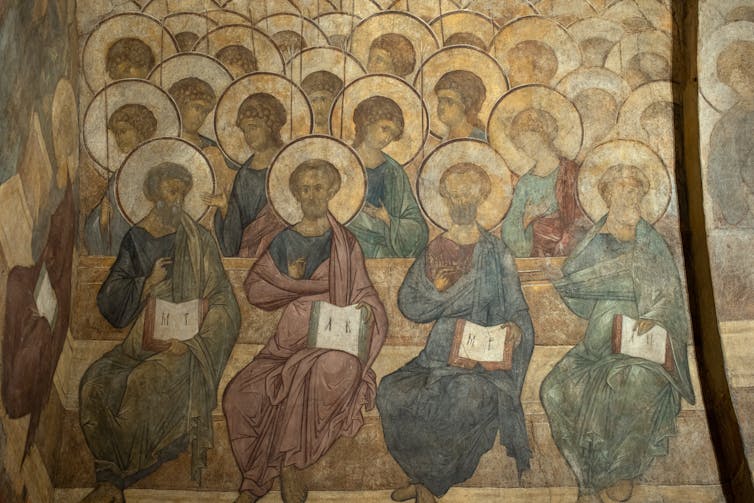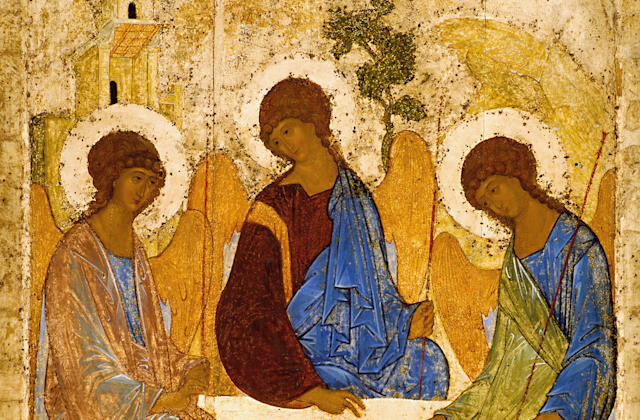Andrey Rublev (or Rublyov – nobody is sure how his name was pronounced) has been described as “the greatest Russian artist who ever lived”, whose work had “a clarity of composition and suave tranquillity of mood peculiarly his own”.
In May 2023, it was announced that under Putin, one of Rublev’s most famous works was to be removed from its restoration team and donated to the Russian Orthodox Church. This has prompted concerns about the conservation of his work.
My new book Andrey Rublev: The Artist and His World is an overview of the master medieval Russian painter. Rublev, active around 1400 in and near Moscow, was a monk and painter of icons, frescoes and (possibly) manuscripts in the tradition of the Orthodox Church.
He was highly regarded in his lifetime and for at least a century thereafter. He is mentioned in the proceedings of the Council of the 100 Chapters in 1551 (a major council ordering the practices of the Russian Church) and in Tale of the Holy Icon Painters in the 17th century.
He is generally thought to have been born in the 1360s. He must have taken monastic orders sometime before 1405, when he was part of a team painting the Kremlin Annunciation Cathedral. He spent his last years in the relatively small Andronikov Monastery on the edge of Moscow (where a museum is now dedicated to him). A gravestone recording his death on January 29 1430 was found in the 18th century. It has since been lost.
The beautiful cathedral of the Andronikov Monastery, now the oldest standing building in Moscow (though damaged in Napoleon’s invasion and fire of 1812), dates from the late 1420s. I believe, though it can’t be proved, that Rublev had a hand in its construction. He certainly did in its painting. As I write in my book, we know little or nothing about the beginnings of Rublev’s life or career.
Searching for Rublev

Any search for Rublev must begin with the icon known as the Old Testament Trinity, properly known as the Hospitality of Abraham. It stood prominently for centuries in the small cathedral of the Trinity Monastery in hilly, forested country approximately 70kms northeast of Moscow.
This monastery had been founded in the previous century by the hermit and spiritual leader Sergius, who was later canonised and considered the patron saint of Russia. It stood above the disputes of princes as a common spiritual centre. The icon was painted in memory of Sergius, a symbolic overcoming of enmity in a fractious land (still under Tartar rule).
Three elegant figures are seated round a plain table. They are neither evidently young nor old, male nor female, but are winged and haloed. They are angels, the figures who appeared to Abraham and Sarah, as recounted in Genesis 18.

They are God’s messengers and deliver the news that, though elderly, Abraham and Sarah will have a son named Isaac. These three figures were taken as symbolic of the Trinity of Father, Son and Holy Spirit
From the traditional scene, Rublev entirely omits Abraham and Sarah, but includes three symbolic items behind the wings – house, tree and mountain. All this has been apparent only since 1919, when the icon had its first proper cleaning. Until then the painting was obscured, first, by darkening of its varnish, then by the elaborate metal casing fitted over it by subsequent tsars.
Since then, historians have been astounded by the rhythm and poise of the figures, their symbolic meaning and the brilliant colouration based on blood-red and ultramarine blue. Soviet art historian M. Alpatov wrote: “In the history of the arts, there is no other one work that, to the same extent as the Trinity, embodies the best spiritual forces of an entire nation.”
What we know about Rublev’s art
Beyond this icon, what did Rublev definitely paint? In 1408, with his fellow monk Daniil, he worked on the great Cathedral of the Dormition in Vladimir, considered the mother church of middle Russia. Its frescoes are in poor condition, but still show Rublev as an artist of great verve. Though the Last Judgement is represented, there are no scenes of hell.
Beyond these, three probable Rublev icons were found in a woodshed in Zvenigorod, west of Moscow, with links to the Trinity Monastery. The icon of St Michael is so like the Trinity angels that it is usually taken as from the same hand. Around 1400 a series of fine gospel books was made for the main Moscow cathedrals.
Among them was the Khitrovo Book, a work of a quality that leads me to suspect Rublev’s work. Rublev’s final project, small decorative window-splays in the Andronikov Monastery is still intact.

The Trinity icon was moved to the Tretyakov Gallery in the 1920s, and – considerably battered, as it was – has been carefully studied, restored and displayed, latterly in an air-conditioned capsule.
So things remained, until in May 2023, when President Vladimir Putin announced that it would be donated to the Russian Orthodox Church, in time for Trinity Sunday (June 4). The restoration team was outraged in view of its fragility – they had no guarantee that the work would be protected once it left their care – but had to submit.
Why should Putin behave in this way? To keep his ally, Patriarch Kirill, head of the Russian Orthodox church, on side? To show that, as boss, he can dispose of valuable possessions? Or (most likely) because he needs that icon’s “help” in his war? Rublev’s great masterpiece went, apparently unprotected, to the modern Christ the Saviour Cathedral in Moscow.
However, to the surprise of visitors, the icon was temporarily spirited away from the cathedral in late July, so that a different, non-Tretyakov restoration team could work on it. It seems the journey of this masterpiece isn’t yet over.

Looking for something good? Cut through the noise with a carefully curated selection of the latest releases, live events and exhibitions, straight to your inbox every fortnight, on Fridays. Launches August 4. Sign up here.

